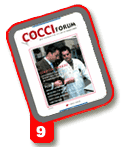COCCI FAQs
Schering-Plough's tech service team answers questions about managing coccidiosis in broilers
Q. I HEARD THAT BY USING PARACOX®-5/COCCIVAC-B IN MY FLOCKS, I CAN SAVE MONEY BY REDUCING THE USE OF STARTER AND GROWER FEEDS WHILE INCREASING THE USE OF LESS EXPENSIVE WITHDRAWAL FEED. WHY WOULD THIS WORK FOR PARACOX-5/COCCIVAC-B AND NOT FOR MY REGULAR IN-FEED ANTICOCCIDIAL CONTROL PROGRAM?
A. Since their introduction in the
1960s, anticoccidials and growth promotants
have largely determined the
duration and design of current poultry
rations. There have been refinements in
rations to reduce overall feed cost and
improve feed efficiency, but the basic
principles of starter/grower/withdrawal
duration and formulation are still based
on maximizing the efficacy of the infeed
medications.
Some of these 40-year-old ration
principles have been challenged in the
past decade with programs using salinomycin
in early feeds paired with a
long withdrawal time. Such programs
rely on the development of immunity
to coccidiosis but, too often, immunity
is still developing when high-yield
breeds are reaching maximum growth
potential. These programs risk a longterm
performance loss as field anticoccidial
resistance increases. In some
cases, full-scale coccidiosis outbreaks
have occurred.
Regardless of whether a classic
starter/grower/withdrawal ration or a
4-week salinomycin/withdrawal program
is used, rations must still be formulated
to maximize the efficacy of the
in-feed anticoccidial. These 40-year-old
ration concepts were not designed for
the high-yield breeds of the twenty-first
century.
Paracox-5/Coccivac-B stimulates predictable
immunity during the early part of the
broiler growth curve, before the maximum
growth rate occurs. Rations can
be formulated more specifically to the
physiological needs of today's highyield
breeds. During the first 14 days,
rations can be designed to maximize
development of the intestine, thyroid
and immune system. Birds then "coast" during the immunity-building phase
from 14 to 21 days, and the growth
curve after immunity is developed can
be maximized. These modern-day
rations are not restricted by the efficacy
requirements of in-feed medications.
Q. WHICH TECHNOLOGY DOES SCHERING-PLOUGH RECOMMEND TO HELP ENSURE EFFICIENT, UNIFORM APPLICATION AND SUCCESSFUL COCCIDIOSIS CONTROL?
A. The best method of applying
Paracox-5 has evolved as knowledge
and technology have permitted.
Initially, the water application method
was used, then the spray-on-feed
method, and now, hatchery spray is
recommended.
The SprayCox II machine with the
dual nozzle system for application on
chicks has improved vaccination coverage
by utilizing a more efficient spray
pattern, which increases the amount of
vaccine applied directly to the chicks.
Q. MY LIVABILITY IS DOWN, CONDEMNATIONS ARE UP AND DERMATITIS IS A PROBLEM. WILL COCCIVAC-B HELP OR MAKE THINGS WORSE?
A. There are many people in the poultry industry who believe that gut health and dermatitis are linked. If the link is real, then improved gut health should lead to a reduced incidence of dermatitis.
Coccivac could help reduce the incidence of dermatitis. If the coccidia load is heavy and ionophores aren't working, coccidiosis vaccination will lead to milder lesions and improved gut health. In turn, this should result in better performance, less downed birds and fewer scratches, which will help reduce the incidence of dermatitis. Improved gut health should also lead to improved bird health and livability.
Contributors -
Delair Bolis, DVM
Charles Broussard, DVM
Steve Fitz-Coy, PhD
Dr. Luciano Gobbi, DVM
John McCarty, DVM
Linnea Newman, DVM
Rick Phillips, DVM
John Radu, DVM
Source: CocciForum Issue No.9, Schering-Plough Animal Health.







